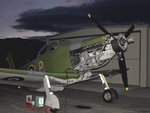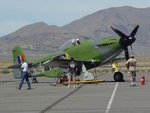wuzak
Captain
Historically, the Martin-Baker M.B.3 was a Sabre powered fighter. It was to be fitted with 6 x 20mm cannon in the wings, but in the event none were fitted.
Three prototypes were ordered in 1940, but the first didn't fly until 1942. No performance measurements were taken before the first prototype crashed (after engine failure), killing its pilot and co-creator, Val Baker.
Maximum speed was said to be around 430mph.
The second and third prototypes were not completed, though one of them may have served as the basis for the M.B.5 prototype.
According to Buttler, British Experimental Combat Aircraft of World War II, Martin-Baker preferred Rolls-Royce engines and wanted the Griffon to power the M.B.3. However, the Griffon had yet to be test flown so could not be considered. So in the mean time the Merlin was to be substituted, and three Merlin Xs were ordered from Rolls-Royce. Later, three Griffons were also ordered.
For an unknown reason the M.B.3 ended up with the Sabre.
What if the Merlin X was fitted to the M.B.3? Could it have matched or exceeded the Spitfire's performance? Or at least bridges the performance gap between the Hurricane and Spitfire?
Since the Griffon was the preferred engine, I would imagine that the Merlin would have been replaced when the Griffon became available. That scould have provided decent performance, and may have formed the basis of an earlier M.B.5.
Martin-Baker were slow getting the M.B.3 to the prototype stage, primarily because they did a lot of urgent conversion and design work for other manufacturers. But if it could have been brought to the prototype stage earlier, it may have been able to be put into production quickly, since it used "simple" steel construction - just like the Hurricane!
Three prototypes were ordered in 1940, but the first didn't fly until 1942. No performance measurements were taken before the first prototype crashed (after engine failure), killing its pilot and co-creator, Val Baker.
Maximum speed was said to be around 430mph.
The second and third prototypes were not completed, though one of them may have served as the basis for the M.B.5 prototype.
According to Buttler, British Experimental Combat Aircraft of World War II, Martin-Baker preferred Rolls-Royce engines and wanted the Griffon to power the M.B.3. However, the Griffon had yet to be test flown so could not be considered. So in the mean time the Merlin was to be substituted, and three Merlin Xs were ordered from Rolls-Royce. Later, three Griffons were also ordered.
For an unknown reason the M.B.3 ended up with the Sabre.
What if the Merlin X was fitted to the M.B.3? Could it have matched or exceeded the Spitfire's performance? Or at least bridges the performance gap between the Hurricane and Spitfire?
Since the Griffon was the preferred engine, I would imagine that the Merlin would have been replaced when the Griffon became available. That scould have provided decent performance, and may have formed the basis of an earlier M.B.5.
Martin-Baker were slow getting the M.B.3 to the prototype stage, primarily because they did a lot of urgent conversion and design work for other manufacturers. But if it could have been brought to the prototype stage earlier, it may have been able to be put into production quickly, since it used "simple" steel construction - just like the Hurricane!



